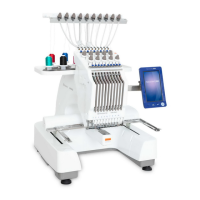Do you have a question about the Husqvarna 1090 and is the answer not in the manual?
Tool for accurately setting the hook timing relative to the needle.
Tool to measure the gap between hook cover and driver.
Gauge used to set the correct feed dog height.
Weight used to calibrate bobbin case thread tension (18-22g).
Tools for setting step motor calibration and needle position.
Device for testing transformer and step motor functionality.
Cassette used for service mode and diagnostics on specific models.
Spanner for belt adjustment and hook-needle gap.
Spanner for setting stitch plate alignment.
Spanner for sideways feed dog adjustment.
Set of hexagonal keys for various motor and timing adjustments.
Specific adam key for presser foot and needle setting.
Tool for adjusting stitch length balance.
Screwdriver with magnetic tip for easier component handling.
Torx screwdrivers for specific screw types.
Angled key for Torx screws in confined spaces.
Essential for protecting electronics from static discharge.
Tool for safely removing components like memo-chips.
Checks for damage or unevenness around the needle hole.
Ensures the presser foot has no scratches on its underside.
Checks for damage on the feed dog teeth and cleanliness.
Inspects the thread tension spring for parallelism and cleanliness.
Verifies the inside of the hook cover is free from damage.
Checks the surface of the driver for wear or damage.
Troubleshooting for the main switch and feed dip button.
Instructions for adjusting the tension of the long cog belt.
Diagram showing connections of external units to the driveboard.
Adjusts the hook gear for proper tangential play.
Sets the correct gap between hook cover and driver for thread passage.
Ensures the presser foot is parallel to stitch plate markings.
Aligns the presser foot with the stitch plate needle hole.
Calibrates the step motor for the sewing head's needle movement.
Positions the needle centrally within the presser foot hole.
Minimizes the gap between the hook tip and the needle.
Centers the stitch plate relative to the needle in the feeding direction.
Synchronizes the hook's rotation with the needle's movement.
Sets the correct vertical position of the needle relative to the hook.
Adjusts the thread resistance of the bobbin case (18-22g).
Sets the automatic thread tension based on fabric and stitch type.
Calibrates the step motor for thread tension adjustment.
Adjusts the thread take-up spring movement completion point.
Ensures the feed dog is parallel to the stitch plate grooves.
Adjusts the side-to-side movement of the feed dog.
Sets the feed dog height between 1.0-1.1mm above the stitch plate.
Adjusts feed dog movement to avoid striking the stitch plate.
Limits bobbin winding when the bobbin is nearly full.
Calibrates stitch length balance for buttonholes and patterns.
Sets the guide step motor for 0.6mm distance.
Sets the guide step motor for 0.0-0.1mm distance.
Calibrates the step motor for side feeding adjustments.
Adjusts the sideways play of the feeding mechanism.
Procedure to remove the upper and lower rear covers.
Steps to detach the lower rear cover.
Instructions for removing the front cover and its components.
Details on dismounting and mounting front cover parts like LCD board.
Procedure for safely exchanging the memo-chip using specialized tools.
Steps to replace the circuit board within the transformer unit.
Instructions for removing the circuit board from 1100/1200 models.
Instructions for removing the circuit board from 1050/1070/1090 models.
Procedure to disassemble and remove the foot control unit.
Steps to remove the feeding guide mechanism.
Steps to install the feeding guide mechanism.
Procedure to remove the connecting rod.
Procedure to install the connecting rod.
Steps to remove the feeding mechanism and stitch regulator fork.
Steps to install the feeding mechanism and stitch regulator fork.
Procedure to remove the complete thread tension device.
Procedure to remove the driver component.
Steps for dismounting and removing the lower shaft.
Detailed steps to remove the sewing head assembly.
Detailed steps to install the sewing head assembly.
Procedure to remove the arm shaft assembly.
Troubleshoots issues with cassette keys not responding.
Diagnoses problems with incorrect cassette recognition.
Troubleshoots non-functional keys on the main control panel.
Diagnoses issues with the sewing advisor function keys.
Troubleshoots upper foil keyboard key failures.
Troubleshoots lower foil keyboard key failures.
General troubleshooting for complete key input failure.
Diagnoses causes for reduced machine operating speed.
Troubleshoots total machine power and function failure.
Diagnoses foot control issues when other functions are active.
Troubleshoots uncontrolled speed or racing issues.
Diagnoses problems with the zig-zag needle movement.
Troubleshoots issues with the machine's feeding mechanism.
Diagnoses and corrects incorrect stitch length balance.
Troubleshoots failures in the automatic thread tension system.
Diagnoses issues with non-functional or partially working LCD displays.
Troubleshoots non-functioning indicator diodes for the sewing advisor.
Diagnoses why the lower thread alarm is not activating.
Troubleshoots sewing with the presser foot in the lifted position.
Diagnoses failure of the buttonhole sensor.
Troubleshoots automatic buttonhole measuring selection.
Diagnoses complete failure of the side motion function.
Troubleshoots display issues related to side motion stitch speed.
Diagnoses issues causing backward-only straight stitching.
Troubleshoots a display where all symbols are flashing.
Tool for accurately setting the hook timing relative to the needle.
Tool to measure the gap between hook cover and driver.
Gauge used to set the correct feed dog height.
Weight used to calibrate bobbin case thread tension (18-22g).
Tools for setting step motor calibration and needle position.
Device for testing transformer and step motor functionality.
Cassette used for service mode and diagnostics on specific models.
Spanner for belt adjustment and hook-needle gap.
Spanner for setting stitch plate alignment.
Spanner for sideways feed dog adjustment.
Set of hexagonal keys for various motor and timing adjustments.
Specific adam key for presser foot and needle setting.
Tool for adjusting stitch length balance.
Screwdriver with magnetic tip for easier component handling.
Torx screwdrivers for specific screw types.
Angled key for Torx screws in confined spaces.
Essential for protecting electronics from static discharge.
Tool for safely removing components like memo-chips.
Checks for damage or unevenness around the needle hole.
Ensures the presser foot has no scratches on its underside.
Checks for damage on the feed dog teeth and cleanliness.
Inspects the thread tension spring for parallelism and cleanliness.
Verifies the inside of the hook cover is free from damage.
Checks the surface of the driver for wear or damage.
Troubleshooting for the main switch and feed dip button.
Instructions for adjusting the tension of the long cog belt.
Diagram showing connections of external units to the driveboard.
Adjusts the hook gear for proper tangential play.
Sets the correct gap between hook cover and driver for thread passage.
Ensures the presser foot is parallel to stitch plate markings.
Aligns the presser foot with the stitch plate needle hole.
Calibrates the step motor for the sewing head's needle movement.
Positions the needle centrally within the presser foot hole.
Minimizes the gap between the hook tip and the needle.
Centers the stitch plate relative to the needle in the feeding direction.
Synchronizes the hook's rotation with the needle's movement.
Sets the correct vertical position of the needle relative to the hook.
Adjusts the thread resistance of the bobbin case (18-22g).
Sets the automatic thread tension based on fabric and stitch type.
Calibrates the step motor for thread tension adjustment.
Adjusts the thread take-up spring movement completion point.
Ensures the feed dog is parallel to the stitch plate grooves.
Adjusts the side-to-side movement of the feed dog.
Sets the feed dog height between 1.0-1.1mm above the stitch plate.
Adjusts feed dog movement to avoid striking the stitch plate.
Limits bobbin winding when the bobbin is nearly full.
Calibrates stitch length balance for buttonholes and patterns.
Sets the guide step motor for 0.6mm distance.
Sets the guide step motor for 0.0-0.1mm distance.
Calibrates the step motor for side feeding adjustments.
Adjusts the sideways play of the feeding mechanism.
Procedure to remove the upper and lower rear covers.
Steps to detach the lower rear cover.
Instructions for removing the front cover and its components.
Details on dismounting and mounting front cover parts like LCD board.
Procedure for safely exchanging the memo-chip using specialized tools.
Steps to replace the circuit board within the transformer unit.
Instructions for removing the circuit board from 1100/1200 models.
Instructions for removing the circuit board from 1050/1070/1090 models.
Procedure to disassemble and remove the foot control unit.
Steps to remove the feeding guide mechanism.
Steps to install the feeding guide mechanism.
Procedure to remove the connecting rod.
Procedure to install the connecting rod.
Steps to remove the feeding mechanism and stitch regulator fork.
Steps to install the feeding mechanism and stitch regulator fork.
Procedure to remove the complete thread tension device.
Procedure to remove the driver component.
Steps for dismounting and removing the lower shaft.
Detailed steps to remove the sewing head assembly.
Detailed steps to install the sewing head assembly.
Procedure to remove the arm shaft assembly.
Troubleshoots issues with cassette keys not responding.
Diagnoses problems with incorrect cassette recognition.
Troubleshoots non-functional keys on the main control panel.
Diagnoses issues with the sewing advisor function keys.
Troubleshoots upper foil keyboard key failures.
Troubleshoots lower foil keyboard key failures.
General troubleshooting for complete key input failure.
Diagnoses causes for reduced machine operating speed.
Troubleshoots total machine power and function failure.
Diagnoses foot control issues when other functions are active.
Troubleshoots uncontrolled speed or racing issues.
Diagnoses problems with the zig-zag needle movement.
Troubleshoots issues with the machine's feeding mechanism.
Diagnoses and corrects incorrect stitch length balance.
Troubleshoots failures in the automatic thread tension system.
Diagnoses issues with non-functional or partially working LCD displays.
Troubleshoots non-functioning indicator diodes for the sewing advisor.
Diagnoses why the lower thread alarm is not activating.
Troubleshoots sewing with the presser foot in the lifted position.
Diagnoses failure of the buttonhole sensor.
Troubleshoots automatic buttonhole measuring selection.
Diagnoses complete failure of the side motion function.
Troubleshoots display issues related to side motion stitch speed.
Diagnoses issues causing backward-only straight stitching.
Troubleshoots a display where all symbols are flashing.
| Brand | Husqvarna |
|---|---|
| Model | 1090 |
| Category | Sewing Machine |
| Language | English |











